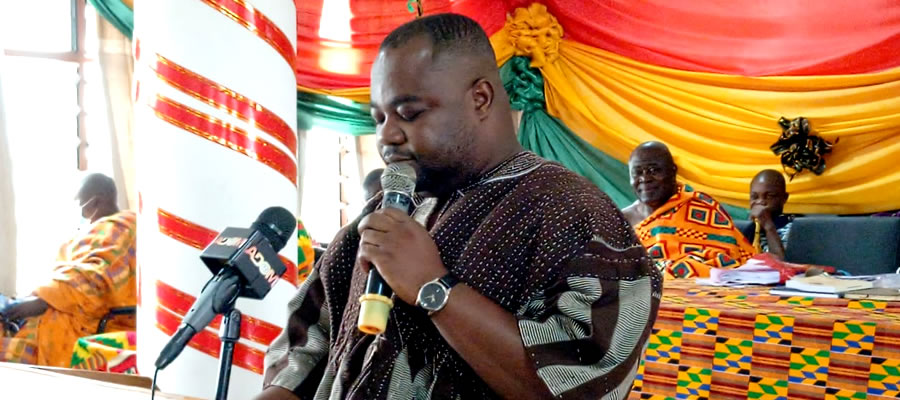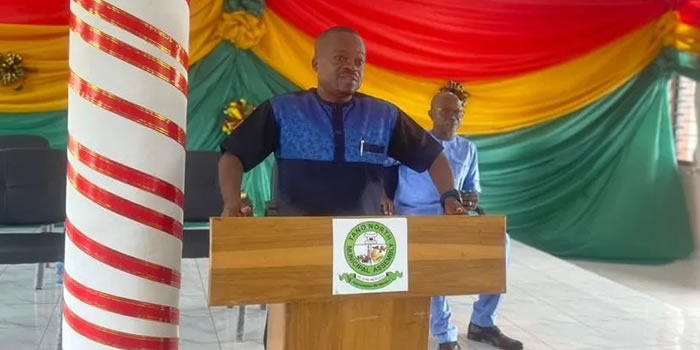

Population
The Tano North Municipal has a total population of 79,973. This constitutes 3.5 percent of the Brong Ahafo Region’s population. There are more females (40,380) than males (39,593) constituting 50.5% and 49.5% respectively in the Municipal. There are almost equal proportions of the population living in urban and rural areas. The sex ratio, defined as the number of males per 100 females is 98.1 for the Municipal indicating more females than males.
About two out of every five (39.9%) people in the Municipal are children younger than 16years; more than half (55.2%) of the population are in the productive age group 15-64 years and only 4.9 percent are aged 65 years and older. As a result, the age dependency ratio for the Municipal is 81.3 implying that every 10 persons in the productive age group have about eight people in the dependent age groups to support. The dependency ratios for the urban and rural areas are 75.8 and 87.1 respectively.
It has a total land area of 876 km2 and constitutes about 1.8% of the total land area of the Brong Ahafo Region. It has a population density of 95.5 persons per square kilometer. The Municipal has experienced increasing population density over the years. The 1960 population density of 29.8 persons per km2 increased to 38.4 persons per km2 in 1970 and 61.7 persons per km2 in 2000. The Municipal figure has been high compared to the region population density of 45.9 persons per km2 in 2000 and 58.4 persons per km2 in 2010.
About two out of every five (39.9%) people in the Municipal are children younger than 16 years and only 4.9% are aged 65 years and older. The total population 15-64 years (conventionally referred to as the labour force) is 55.2 percent of the total population implying a large base of population available to be harnessed for productive work. This also means many resources are needed for the provision of resources and employment opportunities for the youth. The age dependency ration for the Municipal is 81.3 implying that every 10 persons in the productive age group have about eight people in the dependent age groups to support. The dependency ratios for urban and rural areas are 75.8 and 87.1 respectively.
Basically, there are three (3) main religious being practiced in the Municipal namely Christianity, Islam and Traditional Religion. Christians (78.6%) are the dominant religious group with the Pentecostals/Charismatic (27.2%) being higher proportion. Islam (13.8%) is the next dominant religion after Christians. Traditionalists form less than one percent (0.8%) of the population. Those who do not profess any religious belief constitute 6.2 percent of the population in the Municipal. Compared to males, females are in
higher proportions of all the Christian denominations. In contrast, males are in higher proportions than females in the other religious groups as well as those without religion.
Potential Growth Rate
The Tano North Municipal shares boundaries with about four different Municipals. By virtue of its position of being on the Kumasi- Sunyani high way, Duayaw Nkwanta is expanding in almost all its directions, north, south, east and west. However, potential growth points exist in Susuanso, Buokrukruwa, Subompang, Afrispakrom, Nsuapemkrom, Mankranho. The implication here is that, the extension of services particularly utility services such as water and electricity should be of outmost priority to the Municipal Assembly now and in subsequent years to ensure overall development of the Municipal.
Settlement Systems
Spatial Analysis
With a population density of 95.5 persons per square kilometer the Municipal is sparsely populated as compared to the national average of 79.3. The general settlement pattern of the Municipal is the disperse type. The larger settlements namely Yamfo, Bomaa, lie in different routes. This type of settlement hinders the distribution of facilities such as water, schools, health facilities etc.
Hierarchy of Settlements (Scalogram Analysis)
The Scalogram Analysis is used to indicate the hierarchy of settlements in the Municipal. The functional Matrix/Scalogram (Table 9) shows the major settlements, the populations and their corresponding services/facilities existing in them. The facilities used in the Scalogram analysis as can be seen in the matrix are under the following broad sectors;
a. Education
b. Health
c. Agriculture
d. Water and sanitation
e. Banking
f. Market
g. Post and telecommunication
h. Security services
i. Judiciary
j. Roads and
k. Electricity
The frequency of some facilities i.e., Primary and Junior Secondary Schools and boreholes is high 18 communities have Primary School, 13 have J.S.S and 19 have boreholes. Facilities such as the court, hospital, bank and post office have low frequency (i.e. are present in only a few communities).
Ranking of Settlements
Settlements have been scaled in order of their functional influence or centrality using the following criteria;
i. 1st Order - 500
ii. 2ndOrder - 300 - 400
iii.3rd Order - 300
From the Scalogram Analysis, Duayaw Nkwanta the Municipal capital stands out as the 1st Order Settlement with a total centrality score of 1485.2. This is because the community has 27 out of the 35 facilities used in the analysis. Yamfo with total centrality score of 438.5 with 17 facilities is ranked as 2nd Order Settlement. The rest are third (3rd) order settlements.
Implications for Future Interventions/Development
The empty/blank cells on the Scalogram/functional matrix imply that in the Municipal’s future development, more facilities and services should be provided in communities which are least endowed to ensure a more balanced spatial development.
Development Nodes
Analysis of the Scalogram revealed that apart from Duayaw Nkwanta and Yamfo which emerged as 1st and 2nd Order Settlements respectively and which provide more services to their outlying population (catchment areas), the other communities provide little services to their outlying population. In order to accelerate the pace of development of the Municipal, the following communities are being proposed as development nodes/growth poles;
Tanoso
Bomaa
Adrobaa
Terchire
Electricity should be extended to all parts of these communities, health facilities in Bomaa and Adrobaa upgraded, schools turned into model schools with adequate teaching and learning materials and their markets well developed to better serve the neighboring communities.
Spatial Distribution of Population
Population distribution patterns depict the proportion of population living in geographic units, as well as the degree of concentration in such units. The phenomenon of population distribution is influenced by various factors, including topography, availability of water sources, vegetation, soil conditions, and type of economic activity, infrastructure and social amenities. The interplay of these factors, operating through demographic factors, has modified the population distribution of the Tano North Municipal. The relatively high concentration of population in the Municipal is due to the more favourable influences of economic, infrastructural, political and administrative factors which have also helped to retain its continued population growth.
Generally, there is a high concentration of population in the Municipal due to the presence of high number of settlements as well as booming economic activities in the area. The high number of settlements, with a high population concentration, can be explained by the presence of relatively fertile soils. This factor has led to in-migration, as many settlers from the south want to cultivate food and cash crops in this area.
Surface Accessibility to Services
The total length of feeder roads in the Municipal is about 201.65km. The feeder roads in the Municipal on the other hand have been classified as engineered, partially engineered and non-engineered. Out of the total length of 201.65 km of feeder roads, 89.8 km are engineered, 79.95km have been partially engineered while about 31.9km have not been engineered. The condition of the engineered feeder roads is generally good during the dry season but becomes bad in the rainy season while that of the partially and non-engineered feeder road network is bad for most of the year thus hampering access to food production areas.
TNM lies along the Sunyani - Kumasi Highway. Strings of settlements found along the highway are Tanoso, Afrispakrom, Terchire, Koforidua, Susuanho, Duayaw Nkwanta, Buokrukruwa and Boaso. The condition of this highway is in a good shape compared to roads on the south-west side of the Municipal. Communities such as Yamfo and Bomaa are found on the south –west side of the Municipal. The Tanoso – Yamfo road is tarred and fairly good whiles Yamfo to Bomaa road is untarred and in a bad shape. The Yamfo – Bomaa road links to Tepa in the Ahafo Ano North. The condition of the road if improved can serve as linkage between two Municipals and make it much easier for people to commute and convey their farm produce to the market (Bomaa and Yamfo).
Accessibility Analysis
Accessibility generally refers to the ease with which one can lay hands on a particular facility or service. Accessibility can be categorised into, economic, geographical and socio-cultural. Surface accessibility, which is also known as geographical accessibility, refers to the ease with which one travels from a given location to another location(s). This is measured in terms of the time spent in travelling between the two locations (travel time) which also depends on distance, means of transport and the route conditions.
High Access Zone
This refer to all locations in the Municipal that are within reach of a facility or service within a given reasonable travel time. Towns and villages, such as, Duayaw Nkwanta, Tanoso, Afrispakrom, Buokrukruwa, Terchire along the major trunk roads have high access to facilities such as Banks, Schools, Health etc. This implies that such areas are more or less endowed, since at any point in time, one can access any facility with minimum difficulty.
Low Access Zone
A low access zone refers to all locations that are out of reach of the facility or service in question within a given travel time. For example, areas such as, Sukuum, Kwasuagya, Onwi Nkwanta have very low access to a number of facilities, such as hospital, post office, bank, secondary school, etc. This is because communities in the hinterlands have very poor roads and as a result vehicles find it very difficult to ply on them. The inhabitants of these communities have to walk on foot to join a major trunk road before boarding a vehicle. This usually increases the waiting times and thus contributes to the worsening of poverty among the people.
Aggregate Accessibility to Services
It measures the level of accessibility to at least one of a number of individual facilities, such as a Health Centre, a bank, a market, a school, etc. For instance, communities such as Susuanso, Asukese, Ahyiem,, Subonpang have physical access to at least one facility located in the Municipal.
Optimum Accessibility to Services
It is the level of accessibility to all of individual facilities under consideration. This indicates that settlements such as Tanoso, Duayaw Nkwanta, and Yamfo etc have optimum access to facilities such as Health Centre and secondary schools.
Spatial Dimensions of Poverty
The Composite Poverty Map was obtained by superimposing the optimum accessibility map on the tentative poverty pockets map. Based on differences in geographical location, nature and severity of poverty and other factors “pockets of poverty” were carved out. These pockets show the spatial dimensions of the incidence of poverty in the Municipal. A description of the pockets is presented in Table 1.12 and Figure 1.13 depicts the Composite Poverty Map of the Municipal.
Date Created : 11/20/2017 7:09:28 AM












 facebook
facebook
 twitter
twitter
 Youtube
Youtube
 +233 593 831 280
+233 593 831 280 0800 430 430
0800 430 430 GPS: GE-231-4383
GPS: GE-231-4383 info@ghanadistricts.com
info@ghanadistricts.com Box GP1044, Accra, Ghana
Box GP1044, Accra, Ghana